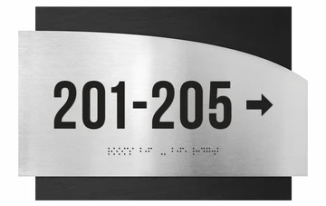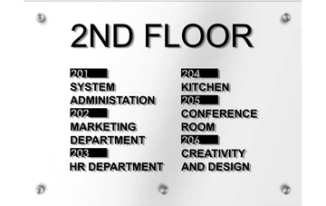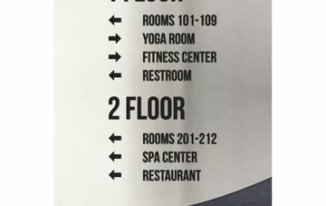Not all road signs show drivers what is allowed and what is not while on the road. Some of the signs simply show the directions to certain locations, whether these are some important points within a neighborhood or neighboring residential areas. The same can be said about interior wayfinding signs.

Wayfinding signs inside a building are your silent guides around the narrow corridors and multiple floors. Using them is an important marker of your caring attitude toward visitors. If you want to learn more about the proper use of wayfinding and directional signs, now is your best opportunity.
Creating a Perfect Wayfinding Sign
To create a perfect set of wayfinding signs for your building you should simply contact the specialists from Bsign Store. But it will still be a useful experience to learn about the criteria that make up a perfect wayfinding sign:

- Minimum information: Curiously, wayfinding signs are the most important informational signs because they inform about the right directions. To deliver this information as effectively as possible, use minimum symbols. A single word or number combined with a directional arrow will be enough.
- Maximum contrast: Clarity and visibility are the ultimate criteria for any wayfinding sign. It is impossible to achieve that without using the contrast of colors. If characters and symbols are made in colors similar to the background plate, they will not be visible from a distance.
- Maximum durability: Although wayfinding signs are mostly used inside the building, they are still prone to physical impact. For those who do not want to buy a new set of signs once a year, it is better to opt for plaques made of durable materials, like stainless steel and acrylic glass. Also, keep in mind that maximum durability can be achieved only as a result of good care and maintenance.
Effective Placement of Wayfinding Signs
Even the best wayfinding signs will not work effectively if they are simply scattered around the building or placed in areas where they are not visible to an average visitor. That is why the placement of signs should also be an important concern for you. The most efficient tactic is to place wayfinding signs next to entry points. The logic behind this idea is quite prosaic: a visitor enters a building or a floor, instantly sees a directional marker, and can quickly choose the right way to go without even hesitating. Also, keep in mind, that wayfinding signs should assist visitors find permanent areas, like restrooms and elevators.
Increasing the Efficiency of Wayfinding Signs

To boost the efficiency of wayfinding signs use them in combination with other helpful markers. For instance, it will be easier for visitors to locate a certain room if it is marked with a number, a direction that was previously shown by the wayfinding sign. Also, you can consider using reception signs, which inform about the location of all the major areas inside the building. For example: room №220 — floor 2; men’s restroom — floor 1. Remember that the best strategy is the one where everything works for the sake of the same purpose.



